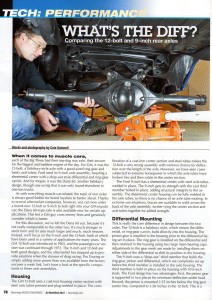
When it comes to muscle cars, each of the Big 3 had their top dog rear axle. Their answer for the biggest and baddest engine of the day. For GM, it was the 12-bolt. A Salisbury style axle with a good-sized ring gear and beefy axle tubes. Ford used its 9-inch. A sheetmetal center with a drop-out style differential and ring-gear carrier. And for Mopar, it was the Dana 60. A Salisbury design so big that is was only found elsewhere in 1-ton trucks.
As with everything muscle car related, the rear axle topic is always good fodder for brand loyalists to banter about. Thanks to several aftermarket companies, however, you can now order a brand new 12-bolt or 9-inch to bolt right into your GM muscle car. This lets a GM guy cross enemy lines and genuinely consider which is better.
We love muscle cars. But some of the 40-year-old technology is a drag to live with, and some elements can take the fun out of driving yourclassic. One example is the exterior lighting. All muscle cars came with incandescent light bulbs of questionable wattage which can make driving at night frustrating and even a bit dangerous.
Your headlights remind you of driving a model T with gas lamps. They were dim and yellowish-brown in the ‘60s and early ‘70s, and they have grown dimmer since day one. These cars came with incandescent bulbs. They give off a warm yellowish light, and did you know that they grow dimmer with every use? The filaments decay when the lights are on, and bits of the metal flake off and float around in the headlight housing. Halogen headlights have a light
Read MoreNot long ago, changing your older muscle car over to a coil-over suspension meant big bucks and a lot of fabricating. This type of suspension was for race cars and serious street performance cars only. Not for the masses, and not for you. Today, thanks in part to a growing number of events that combine driving and racing — road racing, in particular — there are now a number of kits available that make converting to a coil-over suspension system much more feasible for owners of classic muscle cars.